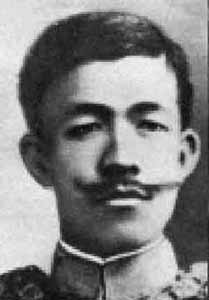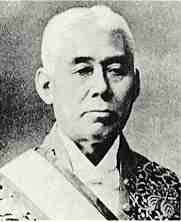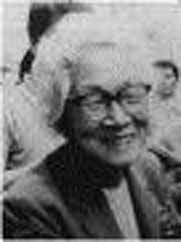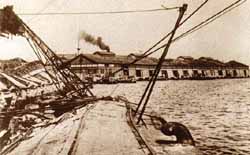Taisho Period1912-1926 |
|
||||||||||||||||||||||||||||||||||||||||||||||||||||||||||||||||||||||||||||||||||||||||||||||||||
PRINCE HARU | WORLD WAR I | POLITICAL CHANGES | WOMEN'S MOVEMENT | WASHINGTON CONFERENCE | ECONOMIC ISSUES | THE GREAT KANTO EARTHQUAKE |
 The
Tashio Period of Japanese History begins with the installation of the surviving
son of Emperor Meiji, Yoshihito. Yoshihito was the third son of Emperor Meiji's
fourteen children. Yoshihito, called Prince Haru by his father, was the son
of a lady-in-waiting named Yanagiwara
Naruko. Empress Shoken, however was regarded as his mother. It is believed
that he contracted meningitis shortly after his birth in 1879. It was rumored
that he had suffered lead poisoning as an infant from breastfeeding from his
nanny. For much of his childhood, he was kept out of the public eye. He was
the first emperor to receive a public education by attending Peers School
which is now called Gakushuin University. On August 31, 1887, he was named
the heir to the throne which was followed with a ceremony making him crown
prince on November 3, 1888. May 25, 1900 he married Sadako who was the daughter
of the head of the Fujiwara clan. They had four sons, the oldest of the them
Hirohito would eventually become Emperor Showa. In 1912, Emperor Meiji died
and the throne passed to Prince Haru. Later in life, Emperor Taisho developed
a mental illness that left him incapacitated. For example, in 1913 at the
opening of the DIet, he was seen forming a telescope out of his speech and
peering through it at political officials like the Prime Minister. He was
often away at Imperial houses. By 1921, his eldest son, Prince Hirohito was
declared Prince Regent and acted in his place. The name Taisho Emperor meaning
Great Righteousness was given to him after his death.
The
Tashio Period of Japanese History begins with the installation of the surviving
son of Emperor Meiji, Yoshihito. Yoshihito was the third son of Emperor Meiji's
fourteen children. Yoshihito, called Prince Haru by his father, was the son
of a lady-in-waiting named Yanagiwara
Naruko. Empress Shoken, however was regarded as his mother. It is believed
that he contracted meningitis shortly after his birth in 1879. It was rumored
that he had suffered lead poisoning as an infant from breastfeeding from his
nanny. For much of his childhood, he was kept out of the public eye. He was
the first emperor to receive a public education by attending Peers School
which is now called Gakushuin University. On August 31, 1887, he was named
the heir to the throne which was followed with a ceremony making him crown
prince on November 3, 1888. May 25, 1900 he married Sadako who was the daughter
of the head of the Fujiwara clan. They had four sons, the oldest of the them
Hirohito would eventually become Emperor Showa. In 1912, Emperor Meiji died
and the throne passed to Prince Haru. Later in life, Emperor Taisho developed
a mental illness that left him incapacitated. For example, in 1913 at the
opening of the DIet, he was seen forming a telescope out of his speech and
peering through it at political officials like the Prime Minister. He was
often away at Imperial houses. By 1921, his eldest son, Prince Hirohito was
declared Prince Regent and acted in his place. The name Taisho Emperor meaning
Great Righteousness was given to him after his death.
Shortly after assuming the throne, the world, including Japan, was plunged into World War I. In direct response to the show of support Britain had made at Emperor Meiji's funeral, Japan officially joined the Allied powers. After declaring war against Germany on August 23, 1914, Japan moved to seize German interests in China. By January 1915, Japan issued Twenty-One Demands to China. This document, presented in secret, had five sections. In the Twenty-one Demands, Japan was to take over Germany's position in Kiaochow. In addition, Manchuria and Mongolia were to be Japanese colonies, Japan would control the coal deposits in China, and guide Chinese military, commercial and financial affairs. These claims were reinforced in 1917 and 1918 treaties. The Chinese refused to sign the Treaty of Versailles due to Japan's control over its territories. This set a policy of Japanese domination over China that would continue into World War II. Toward the end of the war, Japan increasingly filled orders for its European allies' needed war materials. This helped to diversify the country's industry, increase its exports, and transform Japan from a debtor to a creditor nation for the first time. After the Allied victory, Japan was involved in the creation of the League of Nations. Japan proposed a racial equality clause to the League of Nations at the Paris Peace Conference. The United States, Britain and Australia rejected the clause.
Politics during the Taisho period mirrored the global events on the time. During Emperor Taisho's rule, the political power began to move from the upper class to the Diet and the political parties. One of the first examples of the movement toward democracy was the Taisho Democracy Movement in 1913. In 1916 Yoshino Sakuzou published an essay opposing absolutism, militarism and bureaucracy. New political parties like the socialist and communist parties formed in Japan. Much like the rest of the world during this time period, the ideas of Marxism spread to Japan. One long term goal of the Communist Party worldwide was the spread of Communism. In order for a world wide communist revolution to succeed, a communist revolution in Japan was deemed essential. In 1923, The Japan Communist Party announced its goals. They included ending feudalism, abolishing the monarchy, recognizing the Soviet Union, and the withdrawal of troops from areas fighting the spread of communism like Siberia and China. After brutal suppression of the Japan Communist Party, an assassination attempt was made against Prince Regent Hirohito.
 In
1918, Japan saw a first in politics. Hara Takashi, at right, became the first
commoner to serve as Prime Minister. Hara's government faced problems like
inflation, new foreign ideas, transitioning
to a post-war economy, and a growing labor movement. Many of the reforms introduced
to deal with these problems were unsuccessful. New election laws, redistricting,
and public works projects were introduced by Seiyokai, Hara's political party.
The people of Japan were not happy with the growing national debt and wanted
universal male suffrage. In 1921, Hara was assassinated by a railroad
worker. In the years that followed several prime ministers followed. In reaction
to the increased Western influence and the socialist
and communist parties, the Peace Preservation
Law was passed in 1925. This prevented any change in the political structure
and forbade the abolition of private
property. The Peace Preservation Law was largely responsible for the demise
of the Japanese Communist Party. It was forced underground in 1926 and all
be disappeared by 1933.
In
1918, Japan saw a first in politics. Hara Takashi, at right, became the first
commoner to serve as Prime Minister. Hara's government faced problems like
inflation, new foreign ideas, transitioning
to a post-war economy, and a growing labor movement. Many of the reforms introduced
to deal with these problems were unsuccessful. New election laws, redistricting,
and public works projects were introduced by Seiyokai, Hara's political party.
The people of Japan were not happy with the growing national debt and wanted
universal male suffrage. In 1921, Hara was assassinated by a railroad
worker. In the years that followed several prime ministers followed. In reaction
to the increased Western influence and the socialist
and communist parties, the Peace Preservation
Law was passed in 1925. This prevented any change in the political structure
and forbade the abolition of private
property. The Peace Preservation Law was largely responsible for the demise
of the Japanese Communist Party. It was forced underground in 1926 and all
be disappeared by 1933.
 Much
like the United States, Japan saw the growth of a women's movement during
this time period. In 1920, Shin Fujin Kykai was established to challenge legal
restrictions against women. In 1922 Women were allowed to attend political
meetings under the Chian Keisatsu Law. They were, however, not allowed to
be members of these organizations. One of the most famous women involved in
this movement was Fusae Ichikawa, pictured at left. From humble beginnings
as a teacher in 1913 to a reporter, Ichikawa founded the New Women's Association
with fellow women's movement activist Raicho Hiratsuka in 1921. Ichikawa left
Japan in 1921 to study the American women's movement under Alice Paul. Upon
returning to Japan in 1924, she established the Women's Suffrage League of
Japan which existed until 1949. Fusae Ichikawa went on to an active career
in politics serving in Japanese Diet for 25 years and working for women's
rights with the United Nations. Other significant organizations included Sekirankai
or Red Wave Society, a socialist women's group.
Much
like the United States, Japan saw the growth of a women's movement during
this time period. In 1920, Shin Fujin Kykai was established to challenge legal
restrictions against women. In 1922 Women were allowed to attend political
meetings under the Chian Keisatsu Law. They were, however, not allowed to
be members of these organizations. One of the most famous women involved in
this movement was Fusae Ichikawa, pictured at left. From humble beginnings
as a teacher in 1913 to a reporter, Ichikawa founded the New Women's Association
with fellow women's movement activist Raicho Hiratsuka in 1921. Ichikawa left
Japan in 1921 to study the American women's movement under Alice Paul. Upon
returning to Japan in 1924, she established the Women's Suffrage League of
Japan which existed until 1949. Fusae Ichikawa went on to an active career
in politics serving in Japanese Diet for 25 years and working for women's
rights with the United Nations. Other significant organizations included Sekirankai
or Red Wave Society, a socialist women's group.
Due to the instability of China during this period, Japan took an active role on the eastern portion of Asia. Japan built up its presence and power in Korea and China from 1910 through the early 1920s. Japan's interference in China came to an end on February 6, 1922 at The Washington Conference with the signing of the Nine Power Treaty. This treaty, signed by Belgium, Britain, China, France, ITaly, Japan, The Netherlands, Portugal, and the United States, led to the respect of China's independence and the promotion of equal opportunity for trade and industry in China to all nations. Japan also withdrew its troops from portions of China but retained economic rights. Also signed with this was the Five-Power Naval Limitation Treaty. This was signed by France, Great Britain, Italy, Japan and the United States. This was a disarmament treaty with limited the number of ships each country could maintain. Ratios were set up at the conference for ships. The US and Great Britain each were entitled to the highest number of 5 ships to Japan's 3, and 1.67 for France and Italy. This led to scrapping ships in each of the nations that were either built or under construction. The United States and Great Britain also agreed to not build any new military bases between Singapore and Hawaii. This allowed Japan to to have greater freedom and power in the Pacific Ocean. This treaty remained in effect until the mid 1930's when Japan after demanding equality with Great Britain and the United States gave notice it would not remain part of the treaty.
During the Taisho period, the Japanese government faced great economic problems. In 1917 the government took action to stem inflation. Currency was not allowed to leave the country and Profiteering Law was passed. to prevent the inflation of goods like rice and iron. Unfortunately, the Profiteering Law was not successful. In the late summer of 1918, the Tokyo Rice Riots broke out and spread through Japan. By March 1920, the post World War I recession was beginning and strikes swept the ironworks and shipyards. During this time period, Japan depleted its wartime earnings with heavy domestic spending and involvement in CHina. Japan began engaging in competitive business practices, industrialization, and the growth of the zaibatsu to improve its economic status. The US involvement in Asia was seen as preventing the goal of Japanese imperialism.
 In
1923 disaster struck Tokyo. The
Great Kanto Earthquake occurred on September 1, 1923. The earthquake measured
7.9 on the Richter Scale. In comparison, the Great Earthquake of 1906 in San
Francisco was approximately 8.5 on the Richter Scale. The earthquake was centered
around the area of Yokohama, a port city south of Tokyo and portions of Tokyo.
Following the earthquake, fires spread quickly through the area due to high
winds. The earthquake's damage to water mains led to difficulty putting out
fires. It took almost two full days to extinguish the fires. Most of the over
140,000 fatalities were due to the fires. The estimated cost of the earthquake
is estimated over one billion US dollars. During the aftermath of the earthquake,
many minority groups became the victims of violence. Among the groups targeted
were the Koreans, Chinese, and socialists. Thousands of these people were
killed by civilians, military and police.
In
1923 disaster struck Tokyo. The
Great Kanto Earthquake occurred on September 1, 1923. The earthquake measured
7.9 on the Richter Scale. In comparison, the Great Earthquake of 1906 in San
Francisco was approximately 8.5 on the Richter Scale. The earthquake was centered
around the area of Yokohama, a port city south of Tokyo and portions of Tokyo.
Following the earthquake, fires spread quickly through the area due to high
winds. The earthquake's damage to water mains led to difficulty putting out
fires. It took almost two full days to extinguish the fires. Most of the over
140,000 fatalities were due to the fires. The estimated cost of the earthquake
is estimated over one billion US dollars. During the aftermath of the earthquake,
many minority groups became the victims of violence. Among the groups targeted
were the Koreans, Chinese, and socialists. Thousands of these people were
killed by civilians, military and police.
In 1926, Emperor Taisho died ending the Taisho Period and with the crowning of Emperor Hirohito came the beginning of Showa Era.
to return to Mrs. O'Donnell's Home Page.
Maintained according to the Lakeland
Central School District Web Page Policies and Guidelines.
Clicking on the above links will direct you to site(s) outside the Lakeland
Central School District and the Lakeland High School server. The Lakeland
Central School District is not responsible for contents on external sites
and servers, nor does the district endorse the sponsors or advertising on
these sites. This site was designed and maintained by Maureen
O'Donnell, a teacher at Lakeland
High School.
July 2005 Created - |
Saturday, February 25, 2006
Last Revised -













